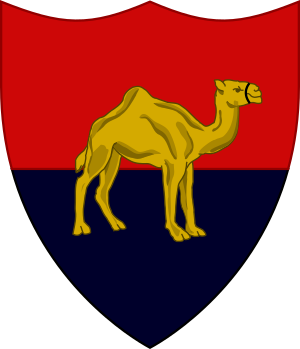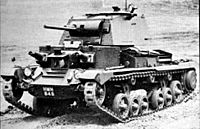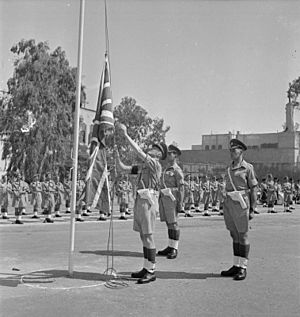Middle East Command facts for kids
Quick facts for kids Middle East CommandMiddle East Land Forces |
|
|---|---|
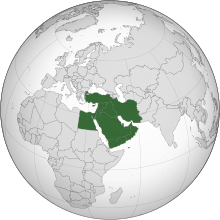
area under the command before separation of Persia and Iraq Command
|
|
| Active | Middle East Command: June 1939 – c. 1946 Middle East Land Forces: 1946–67 |
| Country | |
| Branch | |
| Type | Command |
| Size | 1 million in Second World War |
| Part of | War Office Ministry of Defence (Army) |
| Garrison/HQ | Cairo Suez Canal Zone Cyprus |
| Engagements | Second World War Suez Crisis |
| Commanders | |
| Notable commanders |
Archibald Wavell Claude Auchinleck Harold Alexander |
The Middle East Command was a special group of the British Army. It was set up in Egypt just before the Second World War. Its main job was to lead British ground forces. It also worked with the navy and air force. Their goal was to protect British interests in the Middle East and the eastern Mediterranean Sea.
During the Second World War, this Command managed military actions. These took place in and around the Mediterranean and Middle East. After the Axis forces were defeated in the Western Desert Campaign at the Second Battle of El Alamein, the Command changed. It handed over control of its ground forces to a new group called Allied Force Headquarters. This happened after more British and American troops landed during Operation Torch.
Contents
Setting Up the Middle East Command
The Middle East Command started in Cairo in June 1939. This was because tensions were growing in Europe. Its goal was to create one main command center for the British army. This center would oversee three separate army groups in the Mediterranean and Middle East. These areas included Egypt, Sudan, and Palestine/Transjordan.
In peacetime, the Command led forces in Egypt, Sudan, Palestine, Transjordan, and Cyprus. But if war started, its area would grow. It would then include British Somaliland, Aden, Iraq, and the Persian Gulf. As the war went on, the Command's power spread even further. It covered places like Ethiopia, Eritrea, Libya, and Greece.
Lieutenant-General Sir Archibald Wavell was chosen as the first leader. He started in July 1939.
When the Middle East Command was created, leaders decided all three military branches should work together. This was for the defense of the eastern Mediterranean and Middle East. The Middle East Command only led ground forces. So, three leaders formed a "High Command."
The other two leaders were Admiral Sir Andrew Cunningham for the navy. He was the Commander-in-Chief of the Mediterranean. The third was Air Chief Marshal Arthur Longmore for the air force. He was the Air Officer Commanding-in-Chief of RAF Middle East Command.
Political Guidance
In June 1941, a new role was created. Oliver Lyttelton became the Minister of State in the Middle East. His job was to give political advice to the three military commanders. He also advised on things like propaganda and economic warfare.
The Middle East Command also worked with the French military in the Middle East and Africa. It was also allowed to talk with the Turkish and later the Greek military leaders.
Middle East Command in World War II
On August 30, 1939, the Middle East Command received orders. They were told to take defensive steps against Italy, but to do so carefully. After the war started in September 1939, Poland was quickly defeated. This made an Axis attack from the Balkans a real threat to British areas.
In October 1939, the United Kingdom, France, and Turkey signed a treaty. Lieutenant-General Archibald Wavell signed for the UK. After this, the Middle East Command could start talks with the Turkish military.
Wavell also told his commanders to plan for war with Italy. Lieutenant-General Henry Maitland Wilson planned to capture areas in Libya. He also prepared Egypt for more troops. Other commanders planned to fight Italian forces in Kenya and the Sudan. They also looked into operations in southern Libya.
In February 1940, the leader's title changed to Commander-in-Chief Middle East. Some people thought this name was confusing. They felt it should have been "Army Commander-in-Chief" since it only led ground forces.
For the first nine months of the war, the Middle East was calm. This changed when Italy declared war on June 10, 1940. The East African Campaign then began. Even with fewer troops, Wavell defended against Italian attacks. By May 1941, he had defeated the Italians. He also took over their East African colonies like Eritrea and Ethiopia.
Changes in Command and Campaigns
When problems grew in Iraq, Wavell sent troops there. They stopped a coup d'etat by groups friendly to Nazi Germany. In June 1941, he ordered the invasion of Syria and Lebanon. This was to stop Germany from getting support through these French-controlled areas. In July, he ordered troops to invade Iran with the Soviets. This was to protect oil fields. In August 1942, Iran and Iraq were moved to a new command. This was called the Persia and Iraq Command.
In the Western Desert, the British seemed close to defeating the last Italian forces in Libya by February 1941. But then the war turned. The Germans attacked through the Balkans and took Crete. The Germans also sent the Afrika Korps to Libya, led by Erwin Rommel. The British faced more defeats.
Wavell and Claude Auchinleck then swapped jobs. Auchinleck became the new Commander-in-Chief Middle East. Wavell became the leader in India.
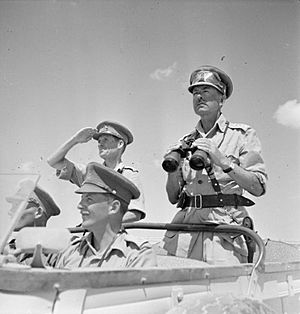
While Auchinleck was in charge, the British Eighth Army fought Rommel's forces. They stopped the German and Italian advance at the First Battle of El Alamein. Auchinleck tried to get his army's different parts to work together better.
Auchinleck faced constant pressure from Prime Minister Winston Churchill. Churchill wanted him to launch an attack. In August 1942, Churchill flew to Cairo. He removed Auchinleck from his role. Auchinleck was replaced by General Sir Harold Alexander. Lieutenant-General Bernard Montgomery became the new commander of the Eighth Army.
Alexander oversaw Montgomery's victory at the Second Battle of El Alamein. After British and American forces met in the Tunisian campaign in January 1943, Alexander became deputy to General Dwight D. Eisenhower.
After the Eighth Army moved to a new command, the Middle East Command became less central. General Wilson took over from Alexander. During his time, the Command had only one major operation. This was the Dodecanese Campaign in 1943, which was not successful.
The Middle East Command's last action was during the Levant Crisis in May and June 1945. British and Indian troops entered Syria. They escorted French forces back to their bases.
Middle East Land Forces After 1945
After 1945, the Middle East Command was renamed Middle East Land Forces (MELF). MELF led forces in Libya until 1957. It also commanded troops in the Suez Canal Zone until the early 1950s. These included the 1st Infantry Division (United Kingdom) and other units.
The Suez base area was very important. It had a long runway at Abu Sueir airfield. This runway could be used by U.S. B-29 Superfortress bombers. These planes could reach Soviet targets far away.
In 1952, the Free Officers in Egypt overthrew King Farouk of Egypt. They were led by Muhammad Naguib and Gamal Abdel Nasser. In 1954, they signed an agreement with Britain. This agreement said British troops would leave the Suez base within 20 months. It also said Britain could return for seven years if needed. In December 1954, MELF's headquarters moved to Cyprus.
To keep British influence, civilian contractors took over the Suez Canal depot area. Between September and December 1955, most MELF depots and workshops were handed over. These included large supply and repair bases.
The last British combat unit to leave the Suez Canal Zone was the 2nd Battalion, Grenadier Guards. They left in March and April 1956. The very last British troops left on June 13, 1956.
In March 1954, British troops in the Sudan included one battalion in Khartoum. The last British troops left Sudan by the end of August 1955.
In April 1960, MELF was reorganized. It included areas in Libya, Cyprus, and Malta. In March 1961, MELF headquarters moved to Aden. It took over the British Forces Arabian Peninsula.
Middle East Land Forces was officially ended on November 28, 1967. British forces in the Persian Gulf were then moved to a new headquarters in Bahrain. This new group was later disbanded in January 1972.
Commanders-in-Chief
Here are some of the leaders of these commands:
Middle East Command
- General Archibald Wavell (1939–1941)
- General Claude Auchinleck (1941–1942)
- General Harold Alexander (1942–1943)
- General Henry Wilson (1943–1944)
- General Sir Bernard Paget (1944–1946)
- General Sir Miles Dempsey (1946–1947)
Commanders-in-Chief, Middle East Land Forces
- General Sir John Crocker (1947–1950)
- General Sir Brian Robertson (1950–1953)
- General Sir Cameron Nicholson (1953)
- General Sir Charles Keightley (1953–1957)
- General Sir Geoffrey Bourne (1957–1958)
- Lieutenant-General Sir Roger Bower (1958–1960)
- General Sir Richard Anderson (1960–1963)
General Officer Commanding Middle East Land Forces
- Major General Philip Tower (until November 30, 1967)


